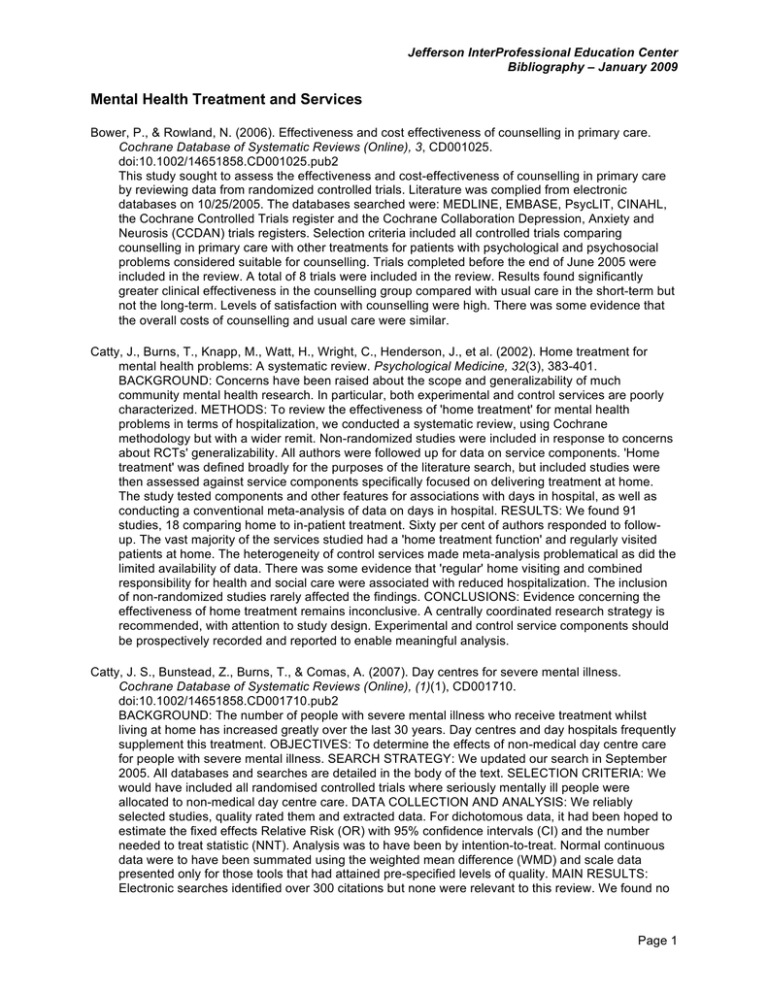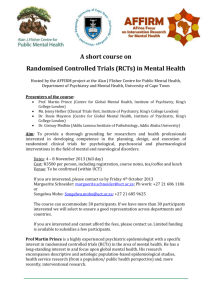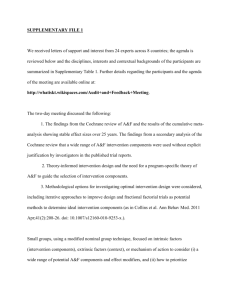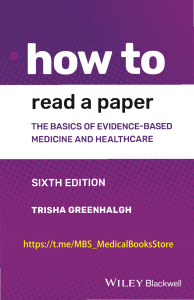Mental Health Treatment and Services
advertisement

Jefferson InterProfessional Education Center Bibliography – January 2009 Mental Health Treatment and Services Bower, P., & Rowland, N. (2006). Effectiveness and cost effectiveness of counselling in primary care. Cochrane Database of Systematic Reviews (Online), 3, CD001025. doi:10.1002/14651858.CD001025.pub2 This study sought to assess the effectiveness and cost-effectiveness of counselling in primary care by reviewing data from randomized controlled trials. Literature was complied from electronic databases on 10/25/2005. The databases searched were: MEDLINE, EMBASE, PsycLIT, CINAHL, the Cochrane Controlled Trials register and the Cochrane Collaboration Depression, Anxiety and Neurosis (CCDAN) trials registers. Selection criteria included all controlled trials comparing counselling in primary care with other treatments for patients with psychological and psychosocial problems considered suitable for counselling. Trials completed before the end of June 2005 were included in the review. A total of 8 trials were included in the review. Results found significantly greater clinical effectiveness in the counselling group compared with usual care in the short-term but not the long-term. Levels of satisfaction with counselling were high. There was some evidence that the overall costs of counselling and usual care were similar. Catty, J., Burns, T., Knapp, M., Watt, H., Wright, C., Henderson, J., et al. (2002). Home treatment for mental health problems: A systematic review. Psychological Medicine, 32(3), 383-401. BACKGROUND: Concerns have been raised about the scope and generalizability of much community mental health research. In particular, both experimental and control services are poorly characterized. METHODS: To review the effectiveness of 'home treatment' for mental health problems in terms of hospitalization, we conducted a systematic review, using Cochrane methodology but with a wider remit. Non-randomized studies were included in response to concerns about RCTs' generalizability. All authors were followed up for data on service components. 'Home treatment' was defined broadly for the purposes of the literature search, but included studies were then assessed against service components specifically focused on delivering treatment at home. The study tested components and other features for associations with days in hospital, as well as conducting a conventional meta-analysis of data on days in hospital. RESULTS: We found 91 studies, 18 comparing home to in-patient treatment. Sixty per cent of authors responded to followup. The vast majority of the services studied had a 'home treatment function' and regularly visited patients at home. The heterogeneity of control services made meta-analysis problematical as did the limited availability of data. There was some evidence that 'regular' home visiting and combined responsibility for health and social care were associated with reduced hospitalization. The inclusion of non-randomized studies rarely affected the findings. CONCLUSIONS: Evidence concerning the effectiveness of home treatment remains inconclusive. A centrally coordinated research strategy is recommended, with attention to study design. Experimental and control service components should be prospectively recorded and reported to enable meaningful analysis. Catty, J. S., Bunstead, Z., Burns, T., & Comas, A. (2007). Day centres for severe mental illness. Cochrane Database of Systematic Reviews (Online), (1)(1), CD001710. doi:10.1002/14651858.CD001710.pub2 BACKGROUND: The number of people with severe mental illness who receive treatment whilst living at home has increased greatly over the last 30 years. Day centres and day hospitals frequently supplement this treatment. OBJECTIVES: To determine the effects of non-medical day centre care for people with severe mental illness. SEARCH STRATEGY: We updated our search in September 2005. All databases and searches are detailed in the body of the text. SELECTION CRITERIA: We would have included all randomised controlled trials where seriously mentally ill people were allocated to non-medical day centre care. DATA COLLECTION AND ANALYSIS: We reliably selected studies, quality rated them and extracted data. For dichotomous data, it had been hoped to estimate the fixed effects Relative Risk (OR) with 95% confidence intervals (CI) and the number needed to treat statistic (NNT). Analysis was to have been by intention-to-treat. Normal continuous data were to have been summated using the weighted mean difference (WMD) and scale data presented only for those tools that had attained pre-specified levels of quality. MAIN RESULTS: Electronic searches identified over 300 citations but none were relevant to this review. We found no Page 1 Jefferson InterProfessional Education Center Bibliography – January 2009 trials of non-medical day centres. AUTHORS' CONCLUSIONS: We feel that the inclusion of any studies less rigorous than randomised trials would result in misleading findings and that it is not unreasonable to expect well designed, conducted and reported randomised controlled trials of day centre care. More precise nomenclature would greatly help identify relevant work. At present nonrandomised comparative studies give conflicting messages about the roles provided by day centres and the clinical and social needs they are able to meet. It is therefore probably best that people with serious mental illness and their carers, if given the choice, take a pragmatic decision on which type of unit best meets their needs. There is a clear need for randomised controlled trials of day centre care compared to other forms of day care, and when resources are limited, day centre care within the context of a pragmatic randomised trial may be the only way of ensuring equity of provision. Freudenstein, U., Jagger, C., Arthur, A., & Donner-Banzhoff, N. (2001). Treatments for late life depression in primary care--a systematic review. Family Practice, 18(3), 321-327. BACKGROUND: Depression is common among older people. It is associated with increased mortality and use of health services. We could identify no prior systematic review of treatment for depression in either primary care attenders or population samples of older people. OBJECTIVES: The aim of this study was to carry out a systematic review of trials of treatments for depression of patients over 60 years of age in primary care or population samples. CONCLUSION: There is little evidence of effectiveness for a variety of treatment approaches for depression in older people in primary care, particularly in those with less severe depression. As older people take more medication, making contra-indications to the use of antidepressant drugs more likely, there is a pressing need for studies of the efficacy of non-pharmacological interventions in primary care settings. Hagar, M. (2005). The convergence of neuroscience, behavioral science, neurology, and psychiatry. New York, NY: Josiah Macy, Jr. Foundation. Inventor, B. R., Henricks, J., Rodman, L., Imel, J., Holemon, L., & Hernandez, F. (2005). The impact of medical issues in inpatient geriatric psychiatry. Issues in Mental Health Nursing, 26(1), 23-46. At an advanced age, serious medical and psychiatric illnesses frequently coalesce. Often, the need for admission to inpatient geriatric psychiatric care arises from coexisting medical problems. While cognitive and behavioral interventions are important, the complexity of physical comorbidities usually becomes the focus of hospitalization and requires intensive medical treatments. This paper describes adaptations made in one metropolitan geriatric psychiatry unit in order to better treat complex patients who experience both medical and psychiatric illness. The need for all members of the interdisciplinary team to expand their practice and the importance of complementary approaches of psychiatry and medicine are emphasized. Page 1





